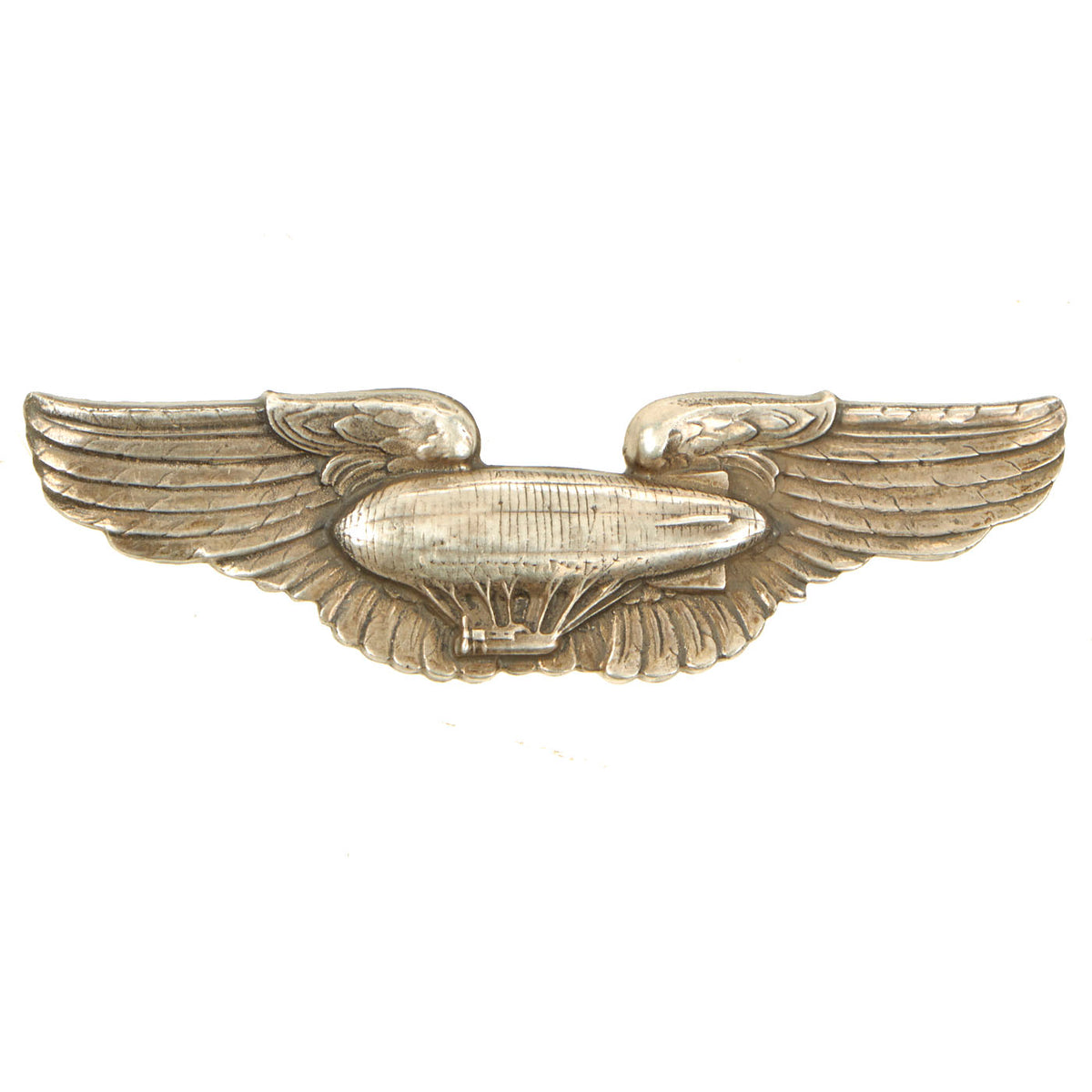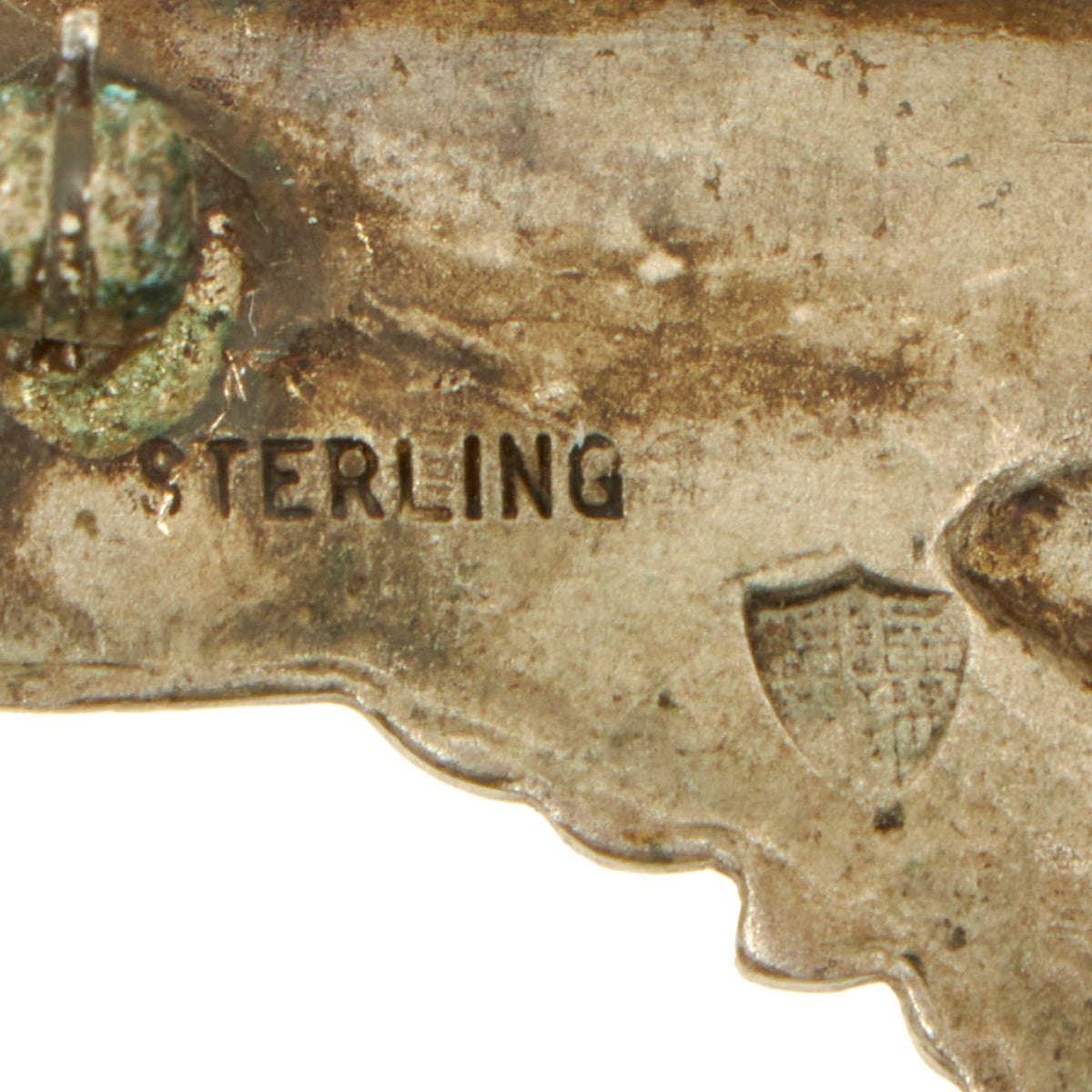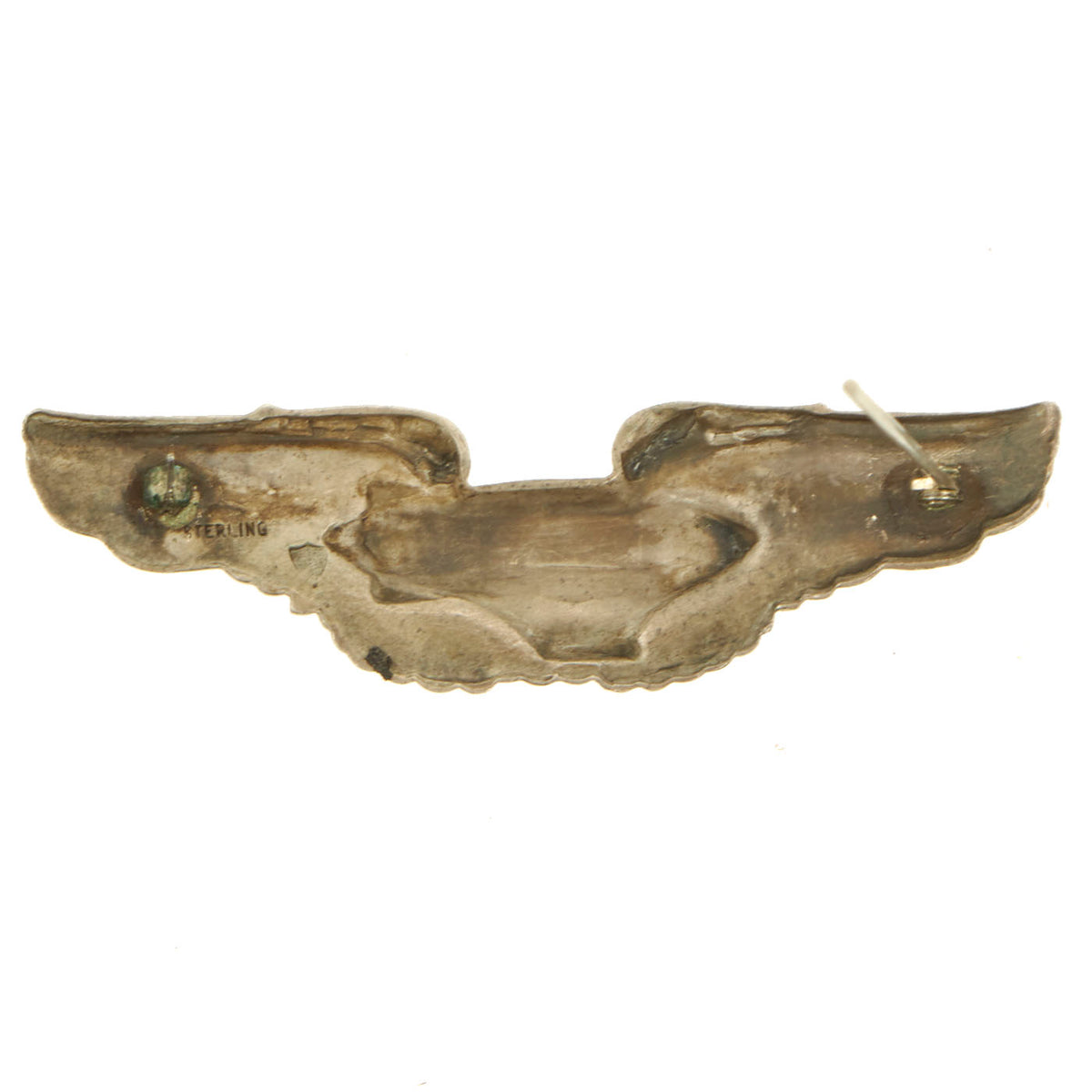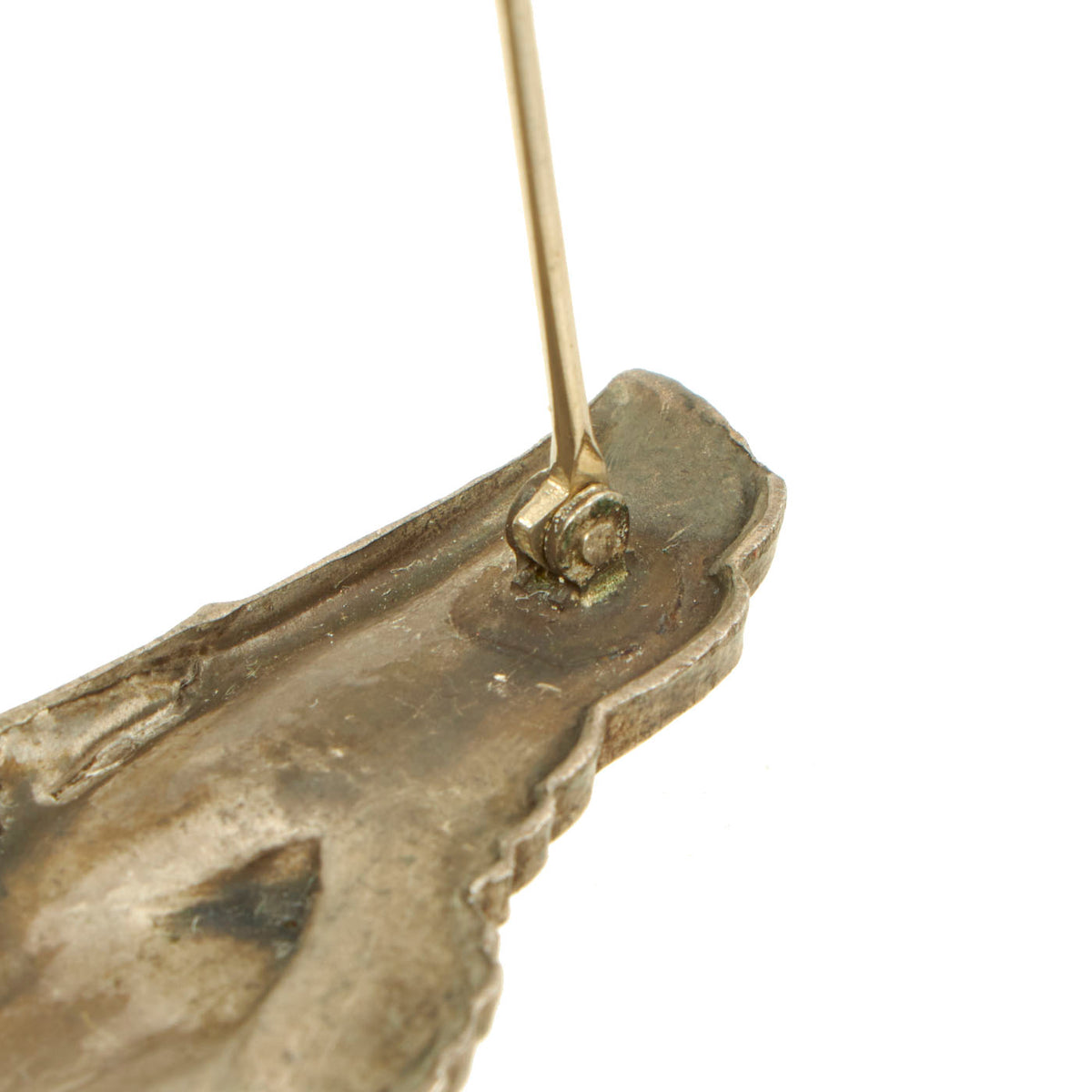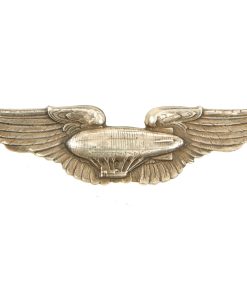Original Extremely Rare U.S. Pre-WWII USAAC Airship Pilot Wings by N.S. Meyer – Sterling Silver Original Items
$ 995,00 $ 248,75
Original Item: Only One Available. This is an excellent example of an Airship Pilots Wings from the early 1930’s. The wings were relatively short-lived, being authorized in Oct of 1921 and abolished in 1940. When the Airship Pilot wing badge was first introduced in October 1921, the airship image seen on it was actually patterned after the U.S. Army RN-1. The RN-1 began life in 1919 as the French built Navy Zodiac ZDUZ-1 and was acquired by the Army that same year. It was extensively modified with a new envelope in 1923 built by Airships Inc. with stronger and lighter tail surfaces built by Wittemann-Lewis Aircraft Co.
The envelope for the RN-1 was 910 feet long, 200 feet high and 185 feet high. It cost $1,500,000 to build in 1919.
The wings here were made by N. S. Meyer of New York. N. S. Meyer was founded in New York City around 1906 by Nathan S. Meyer (1870-1935). However, Nathan Meyer was the son of Simon N. Meyer (1843-after 1910), who established his business in Washington, D. C. (possibly) as early as 1868. Nathan Meyer’s New York business, under the name, N. S. Meyer, at 79 5th Ave. in 1906 is described as “Army and Navy Equipment” in its initial listing in the Manhattan telephone directory. N. S. Meyer was in business in New York from 1906 to 2000. In 2000 they were taken over by Vanguard, another military goods supplier.
The wings measure approximately 3” across and are made of a single struck design. Most of the original plating has been retained and the artwork is still very easily recognizable. The back is “hollow” and the N. S. Meyer “Shield” hallmark and STERLING can be found on the right wing.
This is an excellent example of a rare Army Air Corps Airship Pilots Badge. Comes ready to display!
The history of American military aviation began during the Civil War, when the Union Army operated observation balloons. Later, a balloon was used by the US Army in Cuba during the Spanish–American War. These were ad hoc and not part of an established branch of the Army. The use of observation balloons continued after the end of World War I. The last use of observation balloons by the Army was during maneuvers conducted in Louisiana during September 1941. Balloons must either be tethered, or go where they are blown by the wind, but towards the end of the nineteenth century powered airships, capable of being directed at the will of the pilot, were developed.
In 1908, the US Army experimented with its first powered aircraft, the SC-1, or Signal Corps number 1. It was a small non-rigid airship with a top speed under 20 mph and an endurance of just over 2 hours. Following tests at Fort Myer, the SC-1 was sent to Fort Omaha, Nebraska, where the Signal Corps School was located. While the SC-1 was being tested at Fort Myer, the Signal Corps had built an airship hangar and a plant to produce hydrogen gas at Fort Omaha. Fort Omaha became, for a while, the first permanent military airfield in the United States. The SC-1 was scrapped in 1912, and the base at Fort Omaha closed in 1913.
The US Army operated French observation balloons during World War I, but did not operate another airship until after the war ended. During World War I the Joint Airship Board assigned the US Navy the role of acquiring and developing rigid airships. This did not dissuade the Army from pursuing its own course. Colonel William Hensley flew as an observer on the return voyage of the British R34 airship from Long Island, New York to the UK in the summer of 1919. Hensley was then sent on a confidential mission to contact the Zeppelin Company to attempt to purchase the remaining undelivered wartime Zeppelin, the L 72. The scheme probably originated with General “Billy” Mitchell. Hensley visited the Zeppelin plant, inspected L 72 and flew on the Bodensee, a small passenger Zeppelin. The Inter-Allied Commission of Control ordered that L 72 should be turned over to France. In November 1919 the US Army contracted with the Zeppelin corporation for construction of the LZ 125, which was to be larger than the R38 class airship which the USN had contracted to purchase from Britain as the ZR-2. This attempt to avoid the conditions set by the Joint Airship Board would have encountered legal problems as the US Senate refused to ratify the Allied Peace Treaty with Germany until October 1921. Complaints by the Secretary of the Navy resulted in the Secretary of War ordering the German contract terminated in December 1919.
Following the end of World War I, the U.S. Army acquired a variety of blimps from US, French and British sources. Plans were made for operating airships from both Fort Bliss and Brooks Field, in Texas and Langley Field, Virginia. The first blimp operated by the Army was the A-4, which was operated primarily from Langley until transferred to the new Balloon and Airship School at Fort Scott, Illinois. The Army operated several Navy C class blimps and D class blimps during the immediate post-World War I era.
Army blimps participated in the “Mitchell” bombing test in 1921. They were used for training, coastal patrol, and experimentation in the early 1920s. The Army purchased three British SST class blimps from the British, which were operated out of Biggs Field, Fort Bliss, and Brooks Field, both in Texas for purposes of border patrol between 1920 and 1923.
During the 1920s the Army developed several “Motorized Observation Balloons”. The OB-1 and MB were intended to fly to where needed, and then be tethered as observation balloons.
The US Army acquired the Italian semi-rigid airship Roma in 1921. The Roma was the largest airship ever operated by the Army and was based at Langley Field. With a cruising speed of 50 mph and a range of 7,000 miles, the Roma allowed the Army to consider transcontinental deployments, missions to Panama, the fast transport of cargo and passengers, and long-range sea patrols. The Roma crashed into high-tension wires and was destroyed by fire near Norfolk, Virginia on 21 February 1922. The Roma tragedy led Congress to decree that all future US airships would use non-flammable helium instead of hydrogen as the lifting gas.
During the 1920s and ’30s, the US Army Airship Service was responsible for improvements in airship operation construction. These included the use of internal gondola suspension and the only advanced semi-rigid airship manufactured in America, the RS-1, built by Goodyear. The army operated the RS-1 during the late 1920s until the requirement for a new envelope grounded the ship and resulted in it being scrapped in 1930. The Airship Service also supplied airship pilots and logistic support for stratospheric research flights.
The majority of the airships operated by the US Army during the 1920s and ’30s were of the “TC” Class, designed for coastal patrol duty, because the US Army had long held the primary responsibility for coastal and harbor defense of the US.The airship was seen as capable of searching for hostile ships and tracking those ships until they could be engaged by coastal defenses or Army bombers. One TC class blimp, the C-41, was often used for various public relation experiments in the 1930s, including landing on the Washington D.C. mall to lay a wreath at the Lincoln Memorial and experimenting with picking up mail from a moving train.
Amongst the most interesting U.S. Army Airship Service experiments was to pursue the ability to operate airplanes from airships. While both the Germans and British had experimented with releasing fighters from rigid airships, it was the US Army that first flew an airplane from the ground and ‘hooked’ on to a trapeze suspended from an airship. Many tests involving a Sperry Messenger airplane and TC-3, a TC class blimp, were made in the mid-1920s. Eventually, the technology was adopted by the US Navy on the “flying aircraft carriers”, USS Akron (ZRS-4) and USS Macon (ZRS-5).
The US Army continued to show interest in the acquisition and operation of rigid airships well into the 1930s. The Army Airship Service developed new designs, and operated a number of blimps, primarily from Scott Field and Langley Field through the early 1930s when competition for funding from the rapidly growing Air Corps started its decline. In 1932, the Army contracted for two blimps significantly more capable than any in service, these were the TC-13 and TC-14. When Army Airship operations were terminated in 1937, a number of Army blimps were transferred to the US Navy, but only two, the TC-13 and 14 were ever operated by the Navy.
Washington Monument and two U. S. Army airships- TC 9 and TC 5 on 11 August 1926
Unlike the Navy, the Army had failed during the post-World War I era to establish a definite mission, much less a comprehensive plan for accomplishing that mission, for its airships. By 1935, Congress was considering the elimination of funding for the Army airship program, and Chief of the Air Corps Major General Benjamin Foulois, who himself had been a pilot of the SC-1, was recommending the program be terminated. In mid-1937, the US Army’s airship operations officially ended.
Fast Shipping with Professional Packaging
Thanks to our longstanding association with UPS FedEx DHL, and other major international carriers, we are able to provide a range of shipping options. Our warehouse staff is expertly trained and will wrap your products according to our exact and precise specifications. Prior to shipping, your goods will be thoroughly examined and securely secured. We ship to thousands clients each day across multiple countries. This shows how we're dedicated to be the largest retailer on the internet. Warehouses and distribution centres can be located throughout Europe as well as the USA.
Note: Orders with more than one item will be assigned a processing date depending on the item.
Before shipping before shipping, we'll conduct a thorough inspection of the items you have ordered. Today, the majority of orders will be delivered within 48 hours. The delivery time will be between 3-7 days.
Returns
The stock is dynamic and we cannot completely manage it because multiple stakeholders are involved, including our factory and warehouse. So the actual stock may alter at any time. It's possible that you may not receive your order once the order has been made.
Our policy is valid for a period of 30 days. If you don't receive the product within 30 days, we are not able to issue a refund or an exchange.
You can only return an item if it is unused and in the same state as the day you received it. You must have the item in its original packaging.
Related products
Uncategorized
Uncategorized
Uncategorized
Armored Burgonet Helmet & Polearm from Scottish Castle Leith Hall Circa 1700 Original Items
Uncategorized
Band of Brothers ORIGINAL GERMAN WWII Le. F.H. 18 10.5cm ARTILLERY PIECE Original Items
Uncategorized
Uncategorized
Uncategorized
Angolan Rebel 1970s era 60mm Inert Display Mortar from Angolan Civil War Original Items
Uncategorized
Uncategorized
Uncategorized
Uncategorized
Australian WWII Owen MK1 Machine Carbine SMG Custom Fabricated Replica with Sling Original Items
Uncategorized
Uncategorized
Uncategorized
Uncategorized
Uncategorized
Uncategorized
Uncategorized
Uncategorized
Uncategorized
